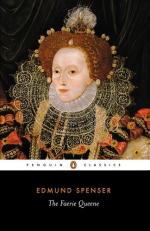25. Paraphrase the involved constructions in xlii, xix, viii, xxxvi.
CANTO VI
I. The Plot: (Continuation of Canto III). Una is delivered from Sansloy by a band of Satyrs. She remains with them as their teacher. There a knight of the wild-wood, Sir Satyrane, discovers her, and by his assistance, Una succeeds in making her way out of the forest to the plain. On the way they meet Archimago, disguised as a pilgrim, and he deceives them and leads them to Sansloy. While Sir Satyrane and Sansloy are engaged in a bloody battle, Una flees. She is pursued by Archimago but makes her escape.
II. The Allegory: 1. Truth is saved from destruction by Lawless Violence (Sansloy) by the aid of Barbarism or Savage Instinct, which terrorizes Lawlessness but offers natural homage to Truth. Truth finds a temporary home among Ignorant and Rude Folk (Satyrs) and in return imparts divine truth to their unregenerate minds. Natural Heroism or Manly Courage (Sir Satyrane) sides with Truth and defends it against Lawlessness.
2. The religious allegory signifies the extension of Protestantism through the outlying rural districts of England and in Ireland. Upton thinks that Sir Satyrane represents “Sir John Perrot, whose behaviour, though honest, was too coarse and rude for a court. ’Twas well known that he was a son of Henry VIII.” Holinshed says that as Lord President of Munster, Sir John secured such peace and security that a man might travel in Ireland with a white stick only in his hand.
16. FROM ONE TO OTHER YND, from the East to the West Indies.
61. A TROUPE OF FAUNES AND SATYRES. The Fauns were the wood-gods of the Romans, the Satyrs the wood-gods of the Greeks. They were half human, half goat, and represented the luxuriant powers of nature.
63. OLD SYLVANUS, the Roman god of fields and woods, young and fond of animal pleasures. Spenser represents him as a feeble but sensuous old man.
90. WITH CHAUNGE OF FEARE, from the wolf to the lion.
96. RUSTICK HORROR, bristling hair.
99. THEIR BACKWARD BENT KNEES, like the hinder legs of a goat.
101. THEIR BARBAROUS TRUTH, their savage honor.
103. LATE LEARND, having been recently taught. She had shown too “hasty trust” in Archimago.
112. WITHOUT SUSPECT OF CRIME, without suspicion of blame.
117. The olive is the emblem of peace, as the ivy (l. 126) is of sensuousness.
120. WITH THEIR HORNED FEET, with their hoofs.
128. OR BACCHUS MERRY FRUIT, etc., whether they did discover grapes.
129. OR CYBELES FRANTICKE RITES, the wild dances of the Corybantes, priestesses of Cybele, or Rhea, the wife of Chronos and mother of the gods.
132. THAT MIRRHOUR RARE, that model of beauty. So Sidney was called “the mirror of chivalry.”




